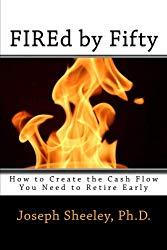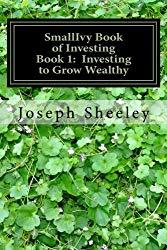When people think of passive income, they usually think of rental apartments and bonds. While it is true that these are great vehicles for passive income, one shouldn’t overlook dividend stocks when it comes to generating income for lifestyle enhancement and retirement bills. Unlike rentals, a dividend stock won’t call you up in the middle of the night complaining that the heater isn’t working (while they have all of the windows open). Unlike bonds, you won’t see your spending power decrease over time and once you lock in your dividend, the effective rate that you receive generally only goes up. But good dividend investing starts early – way before you actually need the money. Today we’ll talk about how to set up a dividend portfolio.
(Note, this site contains affiliate links. When you click on an affiliate link and buy something, The Small Investor will get a small commission for the referral. You are charged nothing extra for the purchase. This helps keep The Small Investor going and free. I don’t recommend any products I do not fully support. If you would like to help but don’t see anything you need, feel free to visit Amazon through this link
Put your budget on steroids. Check out my newest book, FIREd by Fifty: How to Create the Cash Flow You Need to Retire Early

What is a dividend?
When you buy shares of stock, you are becoming an owner in the company. This means that you get to share in the profits (but luckily none of the liabilities). When a company is young and growing quickly, there are normally no profits to share since every dollar is going back into the company. They are expanding business lines, opening new stores, marketing, doing research and development, and buying equipment. Eventually, the company gets to the point, however, where they really don’t need to keep reinvesting everything and can give some of the profits out to the shareholders in a payment called a dividend. This helps support the share price and makes for happy investors. Really, the only reason a stock price goes up is the hope of having a dividend in the future. If companies just reinvested everything and never gave back to the shareholders there would be no reason to buy a stock. Even Apple, which forswore dividends, eventually gave in and started paying one a few years ago.

Apple iPad (Wi-Fi, 32GB) – Space Gray (Latest Model)
The basics of dividends
Dividends are declared by the board of directors each year. They are normally paid out four times a year with the months in which they are paid varying by company. Note that an investor can use this to his/her advantage by either picking companies that pay a dividend in months when the investor has big bills due or picking companies that pay out during different months to produce a steady stream of income. Some companies also pay a special dividend, usually in December, when they have an especially good year and want to reward shareholders with the extra cash.
The ratio of the dollar amount of the dividend per share and the price per share is called the yield. This is kind of like the interest rate you receive for your investment, but it is nothing like a bank interest rate. This is because the yield will vary constantly as the share price changes and the company changes how much they pay. Normally once companies start paying a certain amount per share as a dividend, they are loath to decrease it because that tends to make people sell their shares, so the amount in dollars that you receive each year is unlikely to decrease. The yield you’re receiving, however, will decline as share prices increase and increase as the share price decreases.
As a company becomes more profitable they will often increase their dividend. Many companies like to increase their dividend each year since that will cause a corresponding increase in their share price. Note that the executives at a company are powerfully driven to increase the share price since a lot of their compensation is tied to options that allow them to buy shares above a certain price. The more the stock goes up, the bigger their bonus. High share prices also allow companies to do secondary offerings of shares to fund operations rather than needing to issue bonds. This is preferable since share offerings are basically free while bonds must be paid back with interest. Shares are also often issued as additional compensation for officers and sometimes employees in general.
To learn these characteristics and learn more about the strategy for investing in individual stocks in general, check out the SmallIvy Book of Investing

Why starting early is important
If you go out and look at dividend yields you’ll probably not be that excited. They are way higher than what you can get from a savings account or a short-term CD, but they are not up to bond interest rates. Dividends may be 1-2% when high-quality bonds are paying out 5%. This would mean that you would only generate $10,000-$20,000 on a million dollar portfolio of dividend stocks. Not high living.
But the actual cash payment for share tends to increase over time with dividends where bond payments remain fixed throughout the life of the bond and with subsequent bond offerings unless you get lucky and interest rates are high when it comes time to replace your bonds. If you buy a stock today that is paying $1.00 per share and hold onto it for seven years, if the company is increasing its dividend by 10% per year you’ll be getting $2.00 per share. Hold it another seven years and you’ll be getting $4.00 per share.
This does not mean that the yield will be increasing. It is likely that the share price will increase as the dividend increases, meaning that it may be paying 1% when you buy the stock and still be paying 1% 14 years later when you are getting four times the amount you started with. But to you, based on your initial investment, you are now receiving 4% on your money instead of 1%. Wait another seven years and you’ll be getting an effective rate of 8%, far better than the yield you’ll get from any quality bond unless inflation goes through the roof and interest rates get jacked up really high.
Speaking of interest rates
Just as with bonds, interest rate changes will have a big effect on the price of your dividend-paying stocks. The higher the yield you are receiving, the bigger the effect. The reason is that people mainly buy high-yield stocks for the dividend, so changes in interest rates cause changes in the share price of these stocks to adjust the effective interest rate they are receiving.
For example, let’s say that a stock is priced at $20 and paying a $1.00 per year dividend, for a yield of 5%. If interest rates rise and bank CDs start paying out 5%, no one would want to buy shares of the stock for $20 since they would be getting the same return as they would be from the bank CD. A bank CD payout is guaranteed, where a company can decide to cut a dividend if they get into dire straights. New investors would therefore not be willing to buy shares unless they fell to $12 per share and they would then be getting an effective yield of 8%. This would be a decline of 40% in share value for the investor who bought in at $20, requiring eight years of dividend to replace if the company continues to pay out the same dividend.
Not to fear, however. If interest rates go back down, as they always do, the share price would go up for the same reason it went down in the first place. This means that a shareholder can just hold onto shares and keep collecting the dividends when share prices decline. As long as you’re only interested in income and aren’t trying to make gains on stock price appreciation, the share price should therefore not matter to you. If you want to sell in the future, maybe replacing some of your dividend stocks with bonds to get a higher yield, you can just wait for interest rates to be low since the stock price will likely be high at that point. To gain a better understanding of interest rates, check out Finance and Economics Reimagined: A very simple guide to understanding Interest rate, inflation rate,money supply and much more!
Using yield to value stocks
Yield can also be an effective tool for selecting stocks. If two companies have essentially the same business and the same performance but one has a yield of 1% and the other has a yield of 0.5%, the first stock may be a better value than the first. Note that as many investors buy the first stock, its share price will increase, causing its yield to decrease. Eventually, its yield may decline until it matches that of the second stock.
The issue with selecting between stocks based on yield is that there is usually a good reason for a stock having a lower or higher yield. A company that is killing it will attract more investors since they know that the company will grow its dividend faster than its peers. Likewise, a company that is not performing well and that may need to cut its dividend soon may have a high yield. Be very wary of a company with a really high dividend. That usually means that investors do not think that it will be able to support its dividend for much longer and want to get as much as they can from the company before it does.
That said, using the yield of a stock against its past history is a good way to find stocks that are undervalued. And history has shown that buying stocks that are undervalued is a great way to boost returns. If a company has had a yield in the range of 2% to 3% and it is currently at 3%, that may be a sign that it is undervalued. Likewise, if it is yielding 1% and interest rates aren’t really low, it might not be a good time to invest since it might be due for a correction.
Let’s get to work
OK, so now that you’re an expert on dividends, let’s look at the mechanics. It is helpful to have something like The Value Line Investment Guide so that you have historical information when picking stocks. (Note, I don’t get anything for recommending Value Line. They are just so good that I would be doing the reader a disservice by not mentioning them.)
The first thing to do is to build up a watchlist of 5-10 stocks for your portfolio. You’re looking for strong, stable companies that a pay a decent dividend. For this exercise, let’s use McDonald’s, Home Depot, Duke Energy, Cisco, and Exxon. Looking up their stats, here’s what we see:
Stock Price Yield Dividend
McDonald’s $183 2.53% $4.64
Home Depot $172 2.39% $4.12
Duke Energy $91 4.09% $3.71
Cisco Systems $46 2.88% $1.32
Exxon $76 4.34% $3.28
As you can see, Duke Energy and Exxon are offering much higher yields than the others. It is typical for utilities such as Duke Energy to pay large dividends. They have a heavily regulated industry so there is little reason for them to try to grow. While it may be tempting to focus in one these stocks due to their high yields, some of the other companies may grow more quickly, so their dividends may catch up in the future.
To start, let’s say that we have $2,000 to invest. Given the attractive yield on Exxon, I might go ahead and buy as many shares as I could with the $2,000, so I’d get about 26 shares. I’d then raise another $2,000 and probably buy shares of Duke Energy. Assuming the price does not change dramatically during the period between the time I got he first shares and raised the money for the next shares, I’d get about 22 shares of Duke Energy. I’d not be getting:
(26 shares Exxon)*($3.28/share/yr) = $85.28
(22 shares Duke)*($3.71/shRE/yr) = $81.62
for a total of about $167 per year in income.
I would continue this process, buying shares in each of the companies on my list, until I had about $2,000 in each company. In choosing which company to buy, I would look at the yield of each company versus its historical range, picking whichever company seemed to be the best bargain at the time I was ready to invest. Assuming prices didn’t change much, over a period of a year or two, I might have a portfolio that looks about like this:
(26 shares Exxon)*($3.28/share/yr) = $85.28
(22 shares Duke)*($3.71/shRE/yr) = $81.62
(11 shares McDonald’s)*($4.64/share/yr) = $51.04
(12 shares Home Depot) * ($4.12)/share/year) = $49.44
(43 shares Cisco) * ($1.32/share/yr) = $56.76
This would provide me with a total income of about $320/year. This would be a return of about 3.2% per year.
To infinity, and beyond
As time passed, I’d continue to add to my portfolio each time I had saved up a couple of thousand dollars, choosing whichever stock from my list looked most attractively priced at the current time. The dividends that I am paid would grow as well. I would also take advantage of dividend reinvestment plans, that would both let me both reinvest the dividends that I did not need and add more money to buy more shares without paying a commission. To learn more about DRIPs, take a look at The Little Book of Big Dividends: A Safe Formula for Guaranteed Returns.
Please contact me via [email protected] or leave a comment.
Follow me on Twitter to get news about new articles and find out what I’m investing in. @SmallIvy_SI
Disclaimer: This blog is not meant to give financial planning or tax advice. It gives general information on investment strategy, picking stocks, and generally managing money to build wealth. It is not a solicitation to buy or sell stocks or any security. Financial planning advice should be sought from a certified financial planner, which the author is not. Tax advice should be sought from a CPA. All investments involve risk and the reader as urged to consider risks carefully and seek the advice of experts if needed before investing.
